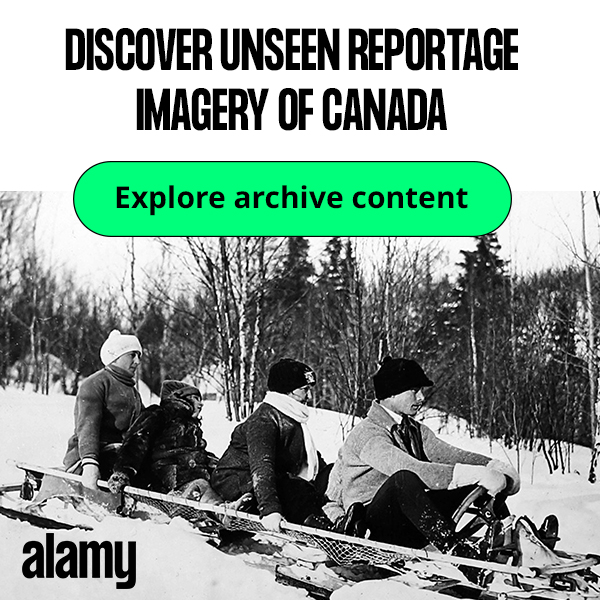The Right to Journey Home
Canadian Commission for UNESCO & Dr. Amy Parent Noxs Ts’aawit
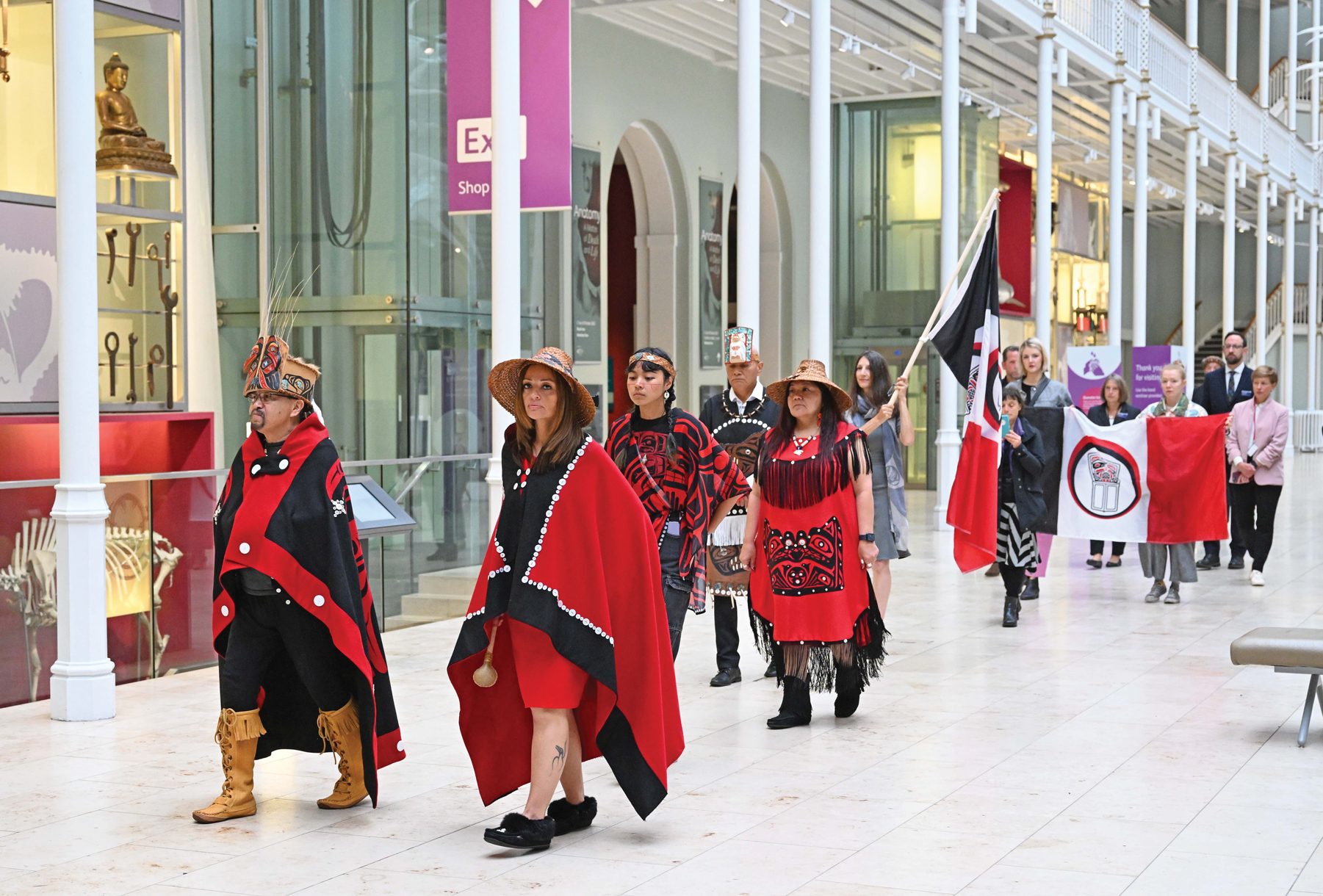
Nisga’a Nation delegates walk through the National Museum of Scotland on August 22, 2022. Photo — Neil Hanna.
The Ni’isjoohl Memorial Pole, a living ancestor of the Nisg̱a’a people, is the first Indigenous pole to be returned from the United Kingdom. In another first, the Nisg̱a’a negotiated its return as a self-governing nation, without influence or intervention from the Canadian government—an achievement that no doubt poses interesting questions for museums in discussions of rematriation.
Raised for the first time in 1860, the pole memorialized Ts’awit, a Nisg̱a’a warrior who died with honour defending his family and Nation. But in 1929, the pole was stolen by an anthropologist named Marius Barbeau. Barbeau sold it to what was then called the Royal Museum of Scotland (now National Museums Scotland), where it has resided ever since.
The pole’s voyage back to its rightful location began with a Nisg̱a’a delegation that had visited Europe some years back to search for Nisg̱a’a belongings. The pole had been found at the National Museums Scotland (NMS), but the delegation was told by museum officials that it was too old to be moved.
Years later, Sim’oogit Ni’isjoohl (Chief Earl Stephens) suggested to his niece that she look into the pole when she was on Nisg̱a’a territory to do some research for a language revitalization project. His niece is Amy Parent, who holds the female version of the name Ts’awit (Sigidimnak Nox Ts’aawit, or Mother of the Raven Warrior Chief) and is also the ancestral granddaughter of the matriarch who originally commissioned and owned the pole. Dr. Parent is also a research specialist, as demonstrated by her role as Canada Research Chair in Indigenous Education and Governance at Simon Fraser University.
Parent’s research would reveal that, in fact, the pole had already been moved at least once during renovations after the delegation’s visit. She concluded that it could be moved again.
In August 2022, she travelled to Scotland with five other Nisg̱a’a Nation members and the curator and director of the Nisg̱a’a Museum to request the return of the pole with the transfer of full legal title and no conditions.
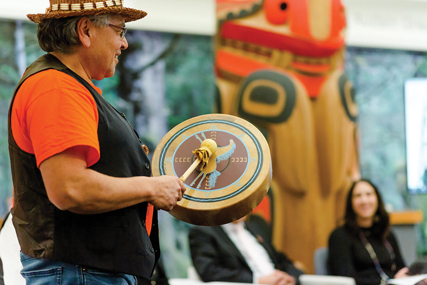
Halayt (Spiritual Person) Bruce Robinson from the Nisga’a Nation drumming for the opening of the Ni’isjoohl Rematriation panel discussion at the Bill Reid Gallery, Vancouver, BC, February 22, 2023. Photo — Maxine Bulloch.
Colliding governance systems
The negotiations began with what Parent characterizes as a “clash of two different knowledges, laws and governance systems.”
Delegation members were worried that NMS staff might reject the rematriation request if they did not understand the Nisg̱a’a Nation’s self-governing status or why the request had come from the Nation rather than from Canada or British Columbia. Early on, the delegation made it clear that they expected the discussions to respect Nisg̱a’a laws and protocols. The Nation is governed by the Nisg̱a’a Lisims Government under the Nisg̱a’a Constitution, which follows Nisg̱a’a Ayuuḵ (ancestral laws and protocols).
For its part, NMS had a document titled Procedure for Considering Requests for the Permanent Transfer of Collection Objects to Non-UK Claimants, and would consider a request for a permanent transfer to a non-UK claimant if the request met certain criteria.
But the procedures set the two sides up for disagreement by characterizing the pole as “property.”
“There were fundamental ontological, epistemological and legal differences in our understanding of the living and spiritual nature of the pole—that sacred belongings are not museum objects that can be owned, and that museum procedures relate only to belongings as property,” says Parent. “So our starting position was that the procedures were not relevant for our discussion.”
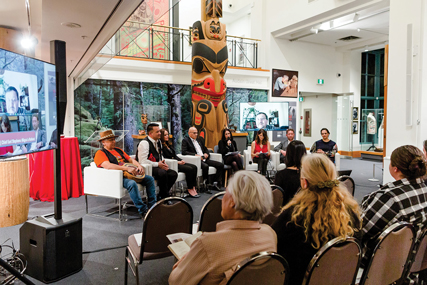
Ni’isjoohl Rematriation panel discussion at the Bill Reid Gallery, Vancouver, BC, February 22, 2023. Panelists from left to right: Halayt (Spiritual Person) Bruce Robinson from the Nisga’a Nation, Apdii Laxha (Andrew Robinson, Nisga’a Lisims Industry Relations Manager), Sigidimnak Noxs Ts’aawit (Dr. Amy Parent), Hlgu Aama Gat (Donald Leeson, Chief Councillor, Laxgalt’sap Village Government), Barbara Filion (Program Officer, Culture, Canadian Commission for UNESCO), Theresa Schober (curator and director of the Nisga’a Museum), Sim’oogit Ni’isjoohl (Chief Earl Stephens, joining virtually on-screen), and Dr. John Giblin and Chanté St Clair Inglis from National Museums Scotland. Photo — Maxine Bulloch.
The Nisga’a Treaty
The delegation provided substantial political, legal and cultural written context before heading to Edinburgh, starting with the Nisg̱a’a Treaty: established in 2000 between the Nisg̱a’a Nation, the Government of British Columbia, and the Government of Canada, the treaty established decision-making authority for a Nisg̱a’a government and laid out the signatory parties’ agreement with respect to the return of Nisg̱a’a artifacts.
“We explained that we were not required to have Canada or British Columbia negotiate on our behalf,” says Parent.
Andrew Robinson, Industry Relations Officer with the Nisg̱a’a Lisims Government, was part of the delegation, and emphasized that the treaty informed the dialogue during the negotiations.
“It enabled us to say we have our own self-governing arrangements and responsibilities for cultural items,” he said. “It allowed the museum to look at us as equals and realize that it is our right to fight for our belongings.”
Although the delegation did not require Canada’s support, Robinson notes that members were grateful to former B.C. Premier John Horgan, who voluntarily supported the rematriation efforts on Twitter after seeing the case in the media.
“As one of his last responsibilities to the Nisg̱a’a Peoples, he sent us a support letter. That letter galvanized Canada to offer us a support letter from the Department of Crown Indigenous Relations and Northern Affairs Canada signifying our respectful relationship with our Treaty partners,” says Robinson.
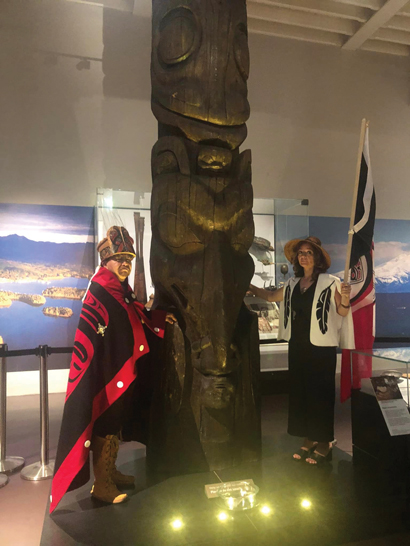
Sim’oogit Ni’isjoohl (Chief Earl Stephens) and Sigidimnak Noxs Ts’aawit (Dr. Amy Parent) with the Ni’isjoohl pole and the Nisga’a flag. Photo — Pamela Brown.
Other supportive frameworks
The United Nations Declaration on the Rights of Indigenous Peoples (UNDRIP) supports repatriation processes to ensure Indigenous property is under the control of Indigenous people. It calls for mechanisms to redress the loss of cultural, intellectual, religious and spiritual property that was taken from Indigenous peoples “without their free, prior and informed consent or in violation of their laws, traditions and customs.”
In addition to Scotland being a signatory of this agreement, in the Canadian context, the Truth and Reconciliation Commission called for federal funding to determine how well museums comply with UNDRIP, which was addressed in the Canadian Museums Association’s “Moved to Action” report.
It’s about applying a lens of sovereignty and self-determination, says Parent. “The Nisg̱a’a laws, UNDRIP and the TRC’s Calls to Action are pivotal turning points. They invite people to recognize their responsibilities to understand the governance structures that exist for Indigenous communities and how we will be walking into these institutions with very different claims, understandings and rights.”
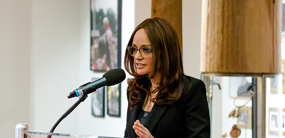
Sigidimnak Noxs Ts’aawit (Dr. Amy Parent) speaking during the Ni’isjoohl Rematriation panel discussion at the Bill Reid Gallery, Vancouver, BC, February 22, 2023. Photo — Maxine Bulloch.
A source of self-determination
The pole’s rematriation was significant for the Nisg̱a’a delegation and community. It was a symbol of the power to reinforce the Nisg̱a’a peoples’ self-governance, pride, memory and cultural sovereignty, says Parent.
In Scotland’s Transnational Heritage: Legacies of Empire and Slavery, Parent wrote, “The destruction, theft, or removal of most pre-contact Nisg̱a’a house poles leaves many Nisg̱a’a people unfamiliar with the stories, history, and traditional place names that are associated with our visual archive… We need our poles to serve as a living curriculum for our next generation of children.”1
This rematriation was significant for the museum as well. Dr. John Giblin, keeper for the Scottish museum’s Department of Global Arts, Cultures and Design, says he felt privileged to witness the moment when the Nisg̱a’a delegation ceremoniously entered the museum to make their case.
“It had been nearly 100 years since the family had been with their ancestor. We were very happy to be able to support that moment,” he says. “It was incredibly emotionally and historically powerful.”
The museum was also able to explore and determine the limits of their legalities. The museum is governed by the National Heritage Scotland Act 1985, which defines how the museum must manage objects in its collection. It is also bound by UK charity law and strives to align with several international conventions. In returning the pole, the museum wanted to be confident that any legal risks were being managed. Chanté St Clair Inglis, head of collection services at NMS, says from the museum’s perspective, the rematriation decision was complicated somewhat by the legal frameworks that govern their operations.
St Clair Inglis advises patience and resolve for those who would like to see museums change. “Be persistent, relentlessly persistent. Change is slow, museum time in particular can move very slowly—but these are changes for the good. We are adding to the stories we tell in our museums and to our collective human history. While we are parting with the pole here in Scotland, we are enriching our understanding in other, better ways.”
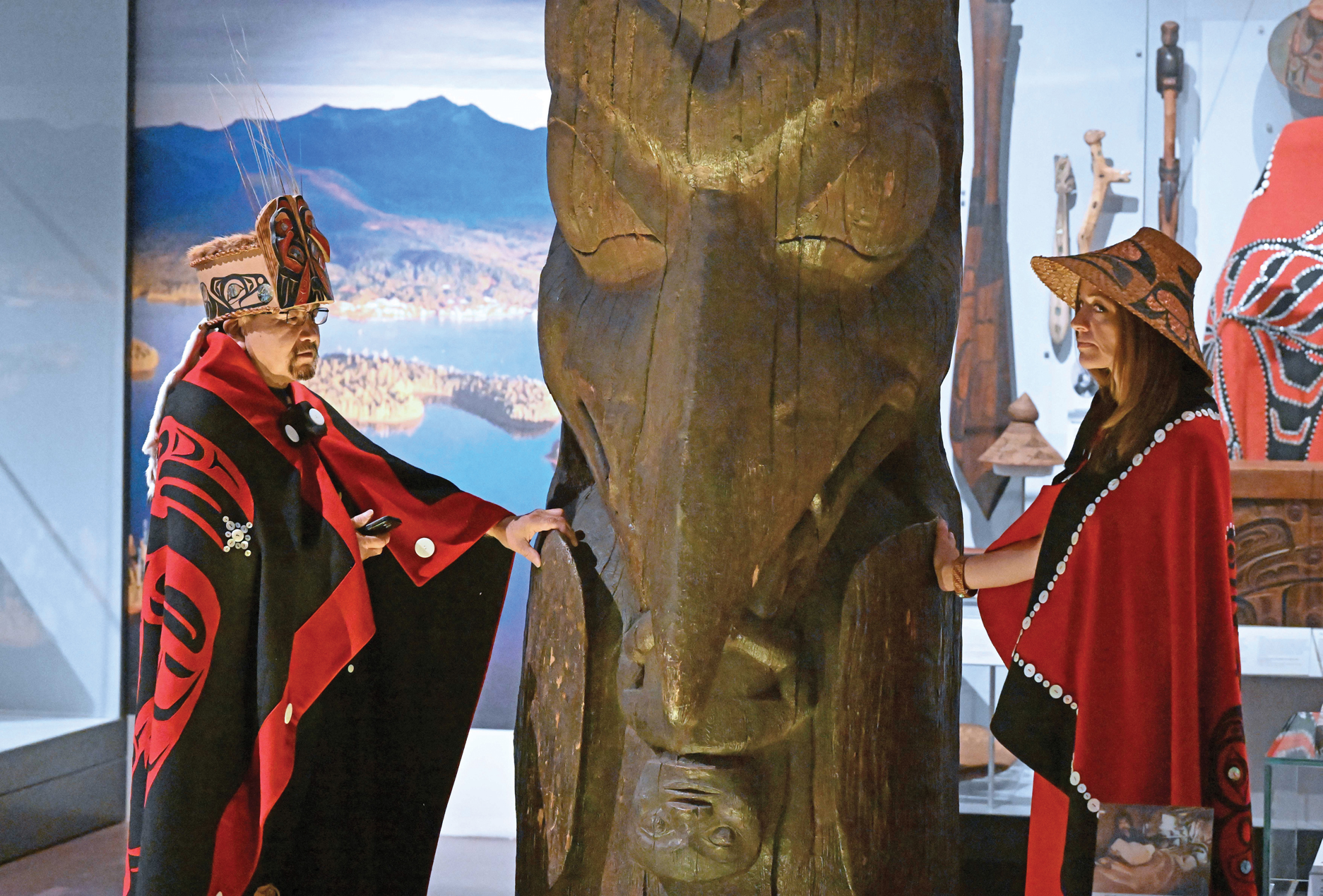
Sim’oogit Ni’isjoohl (Chief Earl Stephens) and Sigidimnak Noxs Ts’aawit (Dr. Amy Parent) seeing the Ni’isjoohl pole for the first time on August 22, 2022. Photo — Neil Hanna.
Some lessons learned
Asked what advice she has for other museums in talks with Indigenous nations about reclaiming cultural heritage, Parent says the first principle is always “Nothing about us without us.”
Donald Leeson, Chief Councillor with the Laxgalt’sap Village Government, says to move mountains, Indigenous people must be grounded in their own culture and educated. “A quote I’ve heard before is: ‘When we know better, we do better.’”
Theresa Schober, curator and director of the Nisg̱a’a Museum, also emphasizes the power of education, but from a different perspective: there is an educational component to helping someone recognize the power structures they may have embedded in their approach.
As for what museums can take from the pole negotiation, they need to learn flexibility, Schobe says. “Just because a policy exists doesn’t mean it needs to be followed. Policies should suit each case and scenario. Look at how you incorporate other knowledge systems so this can be a partnership and true collaboration rather than being dictated by one entity.”
Giblin, NMS’s keeper, says museums shouldn’t view repatriation as a loss.
“There is always the potential for gains through collaborative relationship-building,” he says. “Collections might even grow—for example, through collaborative commissioning.”
Transported by air from Scotland to Canada, the pole receives a memorial procession in Terrance, B.C. that accompanies it home to the Nass Valley. Its home will be the Nisg̱a’a Museum (Wilp-Adokshl Nisg̱a’a) after a ceremony and international feast with dignitaries from the Nisg̱a’a Nation, British Columbia, Canada and Scotland.
Halayt (Spiritual Person) Bruce Robinson says the return of the pole will bring healing to the Nisg̱a’a people.
“Our ancestors are dancing right now,” he says. “We’re bringing a loved one home.”
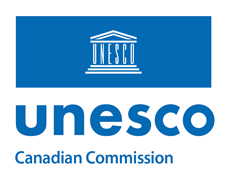
The Canadian Commission for UNESCO (CCUNESCO) helps Canadians share knowledge locally and globally in order to create better societies and build peace in the minds of people.
Dr. Amy Parent’s Nisga’a name is Noxs Ts’aawit (Mother of the Raven Warrior Chief Named Ts’aawit). On her mother’s side of the family, she is from the House of Ni’isjoohl and is a member of the Ganada (frog) clan in the village of Laxgalts’ap in the Nisga’a Nation. On her father’s side of the family, she is of Settler ancestry (French and German). Dr. Amy Parent is an Associate Professor and Canada Research Chair in the Faculty of Education at Simon Fraser University. She is also the Co-Chair of Canada’s federal Tri-Agency Indigenous Leadership Circle in Research; and the inaugural Associate Director for the Cassidy Centre for Educational Justice.
The August 2022 Nisg̱a’a delegation to Scotland was led by Sim’oogit Ni’isjoohl (Chief Earl Stephens), Sigidimnak Noxs Ts’aawit (Dr. Amy Parent), and Shawna Mackay from the House of Ni’isjoohl. It was supported by Hlgu Aama Gat (Donald Leeson, Chief Councillor, Laxgalt’sap Village Government), Apdii Laxha (Andrew Robinson, Nisg̱a’a Lisims industry relations manager), Mmihlgum Maakskwhl Gakw (Pamela Brown), and Theresa Schober (curator and director of the Nisg̱a’a Museum). The 2023 panel discussion, which informed this article, took place at the Bill Reid Gallery of Northwest Coast Art in Vancouver and included these delegation members as well as Halayt (Respected Healer) Bruce Robinson from the Nisg̱a’a Nation, Barbara Filion (Program Officer, Culture, Canadian Commission for UNESCO), and Dr. John Giblin and Chanté St Clair Inglis from National Museums Scotland.
Many of the quotes used in this article were from a panel discussion entitled, Preparing to Bring our Ancestors Home: The Ni’isjoohl Rematriation Panel Discussion. A video of the panel discussion is available online.
| 2015 Recommendation concerning the Protection and Promotion of Museums and Collections, Their Diversity and Their Role in Society UNESCO’s 2015 recommendation is another international standard setting instrument that supports the rightful return of Indigenous belongings. Specifically, Article 18 states: “18. In instances where the cultural heritage of Indigenous peoples is represented in museum collections, Member States should take appropriate measures to encourage and facilitate dialogue and the building of constructive relationships between those museums and Indigenous peoples concerning the management of those collections, and, where appropriate, return or restitution in accordance with applicable laws and policies.” |
1. Parent, A. & Moore, W. (2022). Afterword: Building Solidarity: Moving Towards the Repatriation of the of Ni’isjoohl Totem Pole. In Emma Bond and Michael Morris (Eds.), Transnational Scotland: Empire, Heritage, Stories. Edinburgh University Press (13 pages). https://edinburghuniversitypress.com/pub/media/resources/9781474493529_Moving_Towards_the_Repatriation_of_the_House_of_Niisjoohl_Totem_Pole.pdf
